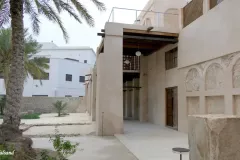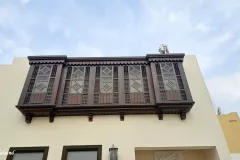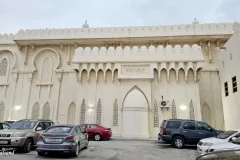Pearling “Testimony of an Island Economy” is a World Heritage Site in the Bahraini city of Muharraq. It was once the centre of the most prosperous pearling industry in the Persian Gulf.
The UNESCO World Heritage List includes over a thousand properties. They have outstanding universal value and are all part of the world’s cultural and natural heritage.
Official facts
- Official title: Pearling, Testimony of an Island Economy
- Country: Bahrain
- Date of Inscription: 2012
- Category: Cultural
UNESCO’s World Heritage Centre’s short description of site no. 1364:
The site consists of seventeen buildings in Muharraq City, three offshore oyster beds, part of the seashore and the Qal’at Bu Mahir fortress on the southern tip of Muharraq Island, from where boats used to set off for the oyster beds. The listed buildings include residences of wealthy merchants, shops, storehouses and a mosque. The site is the last remaining complete example of the cultural tradition of pearling and the wealth it generated at a time when the trade dominated the Gulf economy (2nd century to the 1930s, when Japan developed cultured pearls). It also constitutes an outstanding example of traditional utilization of the sea’s resources and human interaction with the environment, which shaped both the economy and the cultural identity of the island’s society.
More about it
According to UNESCO pearling (pearl hunting or pearl fishing) is an ancient activity. For millennia, the practice of harvesting pearls from oyster beds in the Persian Gulf profoundly influenced the economy of Bahrain. Renowned as the premier source of pearls since antiquity, the pearl industry reached its zenith during the late 19th and early 20th centuries. The prosperity of this global trade is evident in the evolution of Muharraq city’s merchant quarters. Though now diminished, a handful of distinctive commercial and residential structures stand as poignant reminders of this once proud yet perilous economic enterprise. Its catastrophic decline in the 1930s was caused by the emergence of cultured pearls from freshwater mussels in Japan.
The decline coincided with the discovery of oil on the island of Bahrain, and a new industry emerged. The oil industry has had profound effects on the island state’s economy. It will remain so for a few decades more.
My visit
I came here in 2024 and found this heritage site to be the most memorable part of my visit to Bahrain. It is possible to join a guided excursion to the offshore oyster beds to the north, and make an attempt to find an oyster with a pearl inside. If you find one, you are allowed to keep it.
I settled for a walk along what is called the Pearling Path through Muharraq city, once the centre of this industry. The Bahraini has come up with the idea to not only protect a number of residential, commercial and religious buildings. They have also created what they call a path connecting these properties. Click to link above to learn more about it, and read up on the individual buildings.
The path makes for a very easy walk of about 3.5 km right through Muharraq. You may want to follow the map I made (see below), but it is equally easy to follow the lamp-posts. The tall posts with a shining, lit lamp formed like a pearl on top will facilitate your walk day and night. Being a foreign visitor it is always extremely fascinating to walk into a souq or a residential area like this in the Middle East. Sometimes you will find yourself lost in the maze of small alleys and side-streets. The lamp-posts makes this particular walk all the more interesting. And easy.
Impressions
I started in the south, near the old fort, which was closed on my visit, and went a bit more than half the route the first evening. I returned the next afternoon for the remainder of the path. Actually I was also there a third evening, this time as part of a guided group. I did not once feel intimidated or insecure. The walk gave quite the contrary impression, being very exciting in every possible good way. Some of the listed buildings were open for access, others were closed. The Bahraini authorities have done a lot to restore the old listed houses, create small lungs of green, and put up sign-posts.
Not least interesting is the fact that this is both an old town, and also very much alive today. There are traditional small scale commercial areas (no malls!) on the outskirts but for the most part residential neighbourhoods. It might depend on the time of year you visit Muharraq, and the heat of the day, but the streets looked quite empty in the early afternoon. They came to life in the late afternoon and evening. The reason was presumably because this was Ramadan time. This means you should plan your visit.
Muharraq was once on a separate island north of the main island of Bahrain. The islands have since grown together and Muharraq has become very much part of the larger Manama urbanity. Still, this seems to be a very genuine and authentic area, and has retained the old age charm. This is something I missed in Doha and Dubai. I might add that the Manama souq is much more lively than Muharraq and gives you a sense of a genuine Middle Eastern souq too.
Find more
The map below contains many attractions in Bahrain. It will form the basis of my regular travelogue to Bahrain. If you zoom in on the markers in the top section, you will find an outline of the Pearling Path. Blue markers with the UNESCO symbol depicts properties listed by UNESCO and developed by the national authorities of Bahrain. All markers include short descriptions and links to more information.
There is more to learn about the pearling industry in the National museum in Manama, the capital of Bahrain. Three pictures from that museum are included below. Also, read Sandalsand’s other articles from Bahrain. There are two other World Heritage Sites in the country, sad to say much less interesting than this one, but perhaps not less important.

























